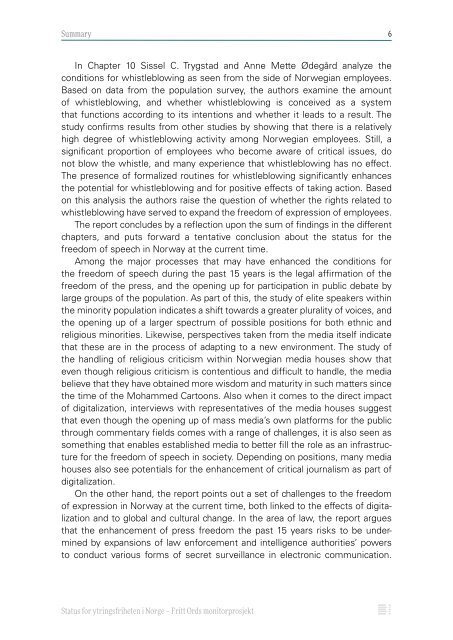Ytringsfrihet Hovedrapport DIG (3)
Ytringsfrihet Hovedrapport DIG (3)
Ytringsfrihet Hovedrapport DIG (3)
You also want an ePaper? Increase the reach of your titles
YUMPU automatically turns print PDFs into web optimized ePapers that Google loves.
Summary6In Chapter 10 Sissel C. Trygstad and Anne Mette Ødegård analyze theconditions for whistleblowing as seen from the side of Norwegian employees.Based on data from the population survey, the authors examine the amountof whistleblowing, and whether whistleblowing is conceived as a systemthat functions according to its intentions and whether it leads to a result. Thestudy confirms results from other studies by showing that there is a relativelyhigh degree of whistleblowing activity among Norwegian employees. Still, asignificant proportion of employees who become aware of critical issues, donot blow the whistle, and many experience that whistleblowing has no effect.The presence of formalized routines for whistleblowing significantly enhancesthe potential for whistleblowing and for positive effects of taking action. Basedon this analysis the authors raise the question of whether the rights related towhistleblowing have served to expand the freedom of expression of employees.The report concludes by a reflection upon the sum of findings in the differentchapters, and puts forward a tentative conclusion about the status for thefreedom of speech in Norway at the current time.Among the major processes that may have enhanced the conditions forthe freedom of speech during the past 15 years is the legal affirmation of thefreedom of the press, and the opening up for participation in public debate bylarge groups of the population. As part of this, the study of elite speakers withinthe minority population indicates a shift towards a greater plurality of voices, andthe opening up of a larger spectrum of possible positions for both ethnic andreligious minorities. Likewise, perspectives taken from the media itself indicatethat these are in the process of adapting to a new environment. The study ofthe handling of religious criticism within Norwegian media houses show thateven though religious criticism is contentious and difficult to handle, the mediabelieve that they have obtained more wisdom and maturity in such matters sincethe time of the Mohammed Cartoons. Also when it comes to the direct impactof digitalization, interviews with representatives of the media houses suggestthat even though the opening up of mass media’s own platforms for the publicthrough commentary fields comes with a range of challenges, it is also seen assomething that enables established media to better fill the role as an infrastructurefor the freedom of speech in society. Depending on positions, many mediahouses also see potentials for the enhancement of critical journalism as part ofdigitalization.On the other hand, the report points out a set of challenges to the freedomof expression in Norway at the current time, both linked to the effects of digitalizationand to global and cultural change. In the area of law, the report arguesthat the enhancement of press freedom the past 15 years risks to be underminedby expansions of law enforcement and intelligence authorities’ powersto conduct various forms of secret surveillance in electronic communication.Status for ytringsfriheten i Norge – Fritt Ords monitorprosjekt


